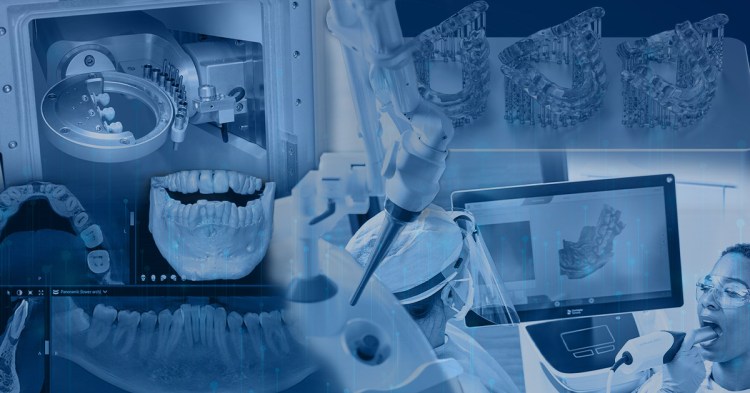Read Time:4 Minute, 54 Second
Dentistry is living a transformative renaissance propelled by cutting-edge equipment and technology, and like it or not, clear lines between the ultra-successful – and everyone else – are being drawn. The honest question for us all is simply, which side of the line do we want to be on?
The integration of scanners, 3D printers, cone beam computed tomography (CBCT), lasers, and milling machines has revolutionized the way dental professionals approach patient care. Yes, a practice can operate without any of these. The question is, can that practice get to the right side of the line? This article explores the pivotal role these technologies play in elevating the standard of dental treatment, ensuring precision, efficiency, and ultimately, optimal patient care.
Digital Scanners: Precision at Your Fingertips
Traditional impressions are gradually becoming relics of the past thanks to the advent of digital scanners. Our ability to quickly and effectively acquire ideal data on every patient with minimal change to our present workflow is practice-altering. Our ability to level up our patient experience simultaneously is both growth and clinical result-altering. The more we shrink the discomfort associated with traditional impressions, the more patients say yes to the true treatment they need rather than the tooth-at-a-time care that’s limited their total health.
The more we integrate this very foundational technology, the better we can stack other technologies that drive greater precision, accuracy and patient convenience.
3D Printing: Redefining Dental Prosthetics
The integration of 3D printing technology has ushered in a new era in the fabrication of dental prosthetics. 3D printers allow for the production of highly customized and intricate dental appliances.
Think removable prosthetics. If you’ve been practicing for any length of time, my guess is you’ve dodged the denture game as frequently as you’ve been able to. Why? Too many appointments, too many variables – which leads to too many unhappy patients – and too many sore spot checks. I could go on. I know you’ve lived or continue to live it.
Imagine traditional or implant-supported and removable becoming as predictable as a crown. Imagine three appointments from start to finish. Imagine excited patients with incredible retention and few to no sore spots.
Then add the new doors 3D printing has opened – things like surgical guides for implant placement and within short order, chairside crowns at a fraction of the cost and speed.
Cone Beam Computed Tomography (CBCT): A Window into Oral Anatomy
CBCT imaging has emerged as an indispensable tool in modern dentistry, offering a three-dimensional view of the oral and maxillofacial structures. Unlike conventional two-dimensional radiographs, CBCT provides detailed, cross-sectional images that aid in precise diagnosis, treatment planning, and execution.
Endodontic diagnosis, vertical fractures, implant planning and placement, and third molar removal are just a short list of our day-to-day problems solved.
Add in today’s low radiation exposure, and I’ve lost every reason that held me back when I was in your shoes and deciding to make the move or not.
CBCT imaging has emerged as an indispensable tool in modern dentistry, offering a three-dimensional view of the oral and maxillofacial structures. Unlike conventional two-dimensional radiographs, CBCT provides detailed, cross-sectional images that aid in precise diagnosis, treatment planning, and execution.
Endodontic diagnosis, vertical fractures, implant planning and placement, and third molar removal are just a short list of our day-to-day problems solved.
Add in today’s low radiation exposure, and I’ve lost every reason that held me back when I was in your shoes and deciding to make the move or not.
Laser Technology: Minimally Invasive Precision
Total transparency: Although I’ve been a soft tissue laser user for 25 years, I’m new to hard tissue lasers. Total transparency: I haven’t been this excited about a technology since my very first scanner 20+ years ago.
Hard or soft tissue lasers offer us total control of the field. Our dentistry is far less invasive – our ability to intervene early and save tissue, time and money for our patients is unparalleled. We now perform bony periodontal crown lengthening with no bleeding, reduced post-op discomfort, and an accelerated healing process.
We’re preparing teeth anesthesia-free daily – Class I, II, III, IV, V and VI. Sealants and sterilization of our preps is a breeze. And OSA – yes, CPAP is the gold standard when a patient wears it. Yes, oral appliances are effective – when patients wear them – yet enter our ability to re-contour soft palates, with more patients getting more optimal care more often.
CAD/CAM Milling: Crafting Precision in Real-Time
We’ve been milling 70% of our restorations chairside for 20 years. The right milling machines enable the production of crowns, veneers, and inlays/onlays with remarkable efficiency and accuracy, especially with today’s material options.
Think about every patient who has returned for insert and had suspect tissue. Think about every patient with questionable pulpal status. Our ability to produce real-time restorations chairside gives us control over tissue and time.
Wrapping Up
The integration of advanced equipment and technology has propelled dentistry into a new era of precision, efficiency, and patient-centric care. Digital scanners, 3D printers, CBCT imaging, lasers, and CAD/CAM milling work synergistically to optimize treatment outcomes, enhance patient comfort, and streamline dental workflows.
I wish I could tell you the line in the sand was blurry. I wish I could tell you it wasn’t coming for 5+ years. But the tech-driven practice isn’t just here – it is redefining our success.


